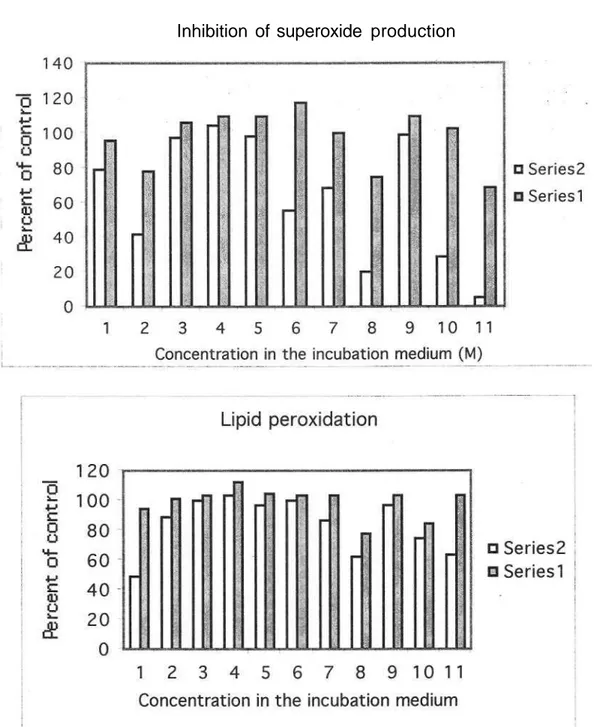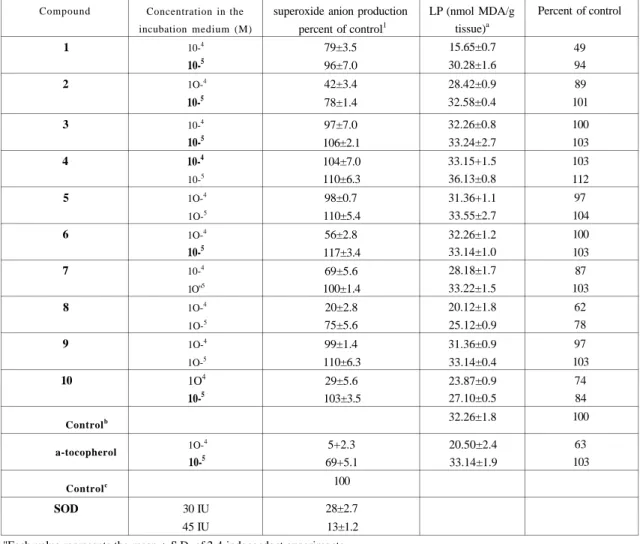ANTIOXIDANT ACTIVITY OF N-SUBSTITUTED İNDOLE 2- AND 3-CARBOXAMIDES
N-SÜBSTİTÜE İNDOL-2 VE 3-KARBOKSAMİTLERİN ANTİOKSİDAN AKTİVİTESİ
Süreyya ÖLGEN1, Tülay ÇOBAN2
'Ankara University, Fakulty of Pharmacy, Department of Pharmaceutical Chemistry 06100 Tandoğan- Ankara, TURKEY
2Ankara University, Fakulty of Pharmacy, Department of Pharmaceutical Toxicology 06100 Tandoğan- Ankara, TURKEY
ABSTRACT
A series of N-substituted indole amide derivatives was tested for in vitro effects on rat liver microsomal NADPH-dependent lipid peroxidation (LP) and superoxide anion (SOD) formation. Vitamin E (a-tocopherol) decreased the LP level by about 63% at 104M concentration. A significant decrease in male liver microsomal LP level was noted for the compounds 1, 8 and 10 at a concentration of 104M comparing with a-tocopherol. The inhibition of 02( by compounds 8 and 10 were found highly efficient. Both activity results show that these compounds are promising antioxidants.
Key Words: Antioxidant activity; N-substituted and N-H indole amide derivatives; superoxide dismutases; lipid peroxidation
ÖZET
Bir seri N-sübstitüe indol amid türevinin, sıçan karaciğerinden elde edilen mikrozomal NADP'ye bağımlı lipid peroksidasyon (LP) ve süperoksit anyon şekillenmesi üzerinde olan invitro etkileri test edildi. Vitamin E (a-tokoferol), LP seviyesini 10'4 M konsantrasyonda yaklaşık % 63 kadar azalttı. Bileşiklerden 1,8 ve 10'ün 10'4 M konsantrasyonda, a-tokoferol ile karşılaştırıldıklarında erkek karaciğer mikrozomal LP düzeylerinde belirgin bir azalmaya neden olduğu bulundu. Bileşiklerden 8 ve 10'ün, ö2(~ anyonunu belirgin bir biçimde inhibe ettiği bulundu. Her iki aktivite sonucu, bu bileşiklerin ümit verici antioksidanlar olabileceklerini gösterdi.
Anahtar Kelimeler: Antioksidan aktivite; N-sübstitüe indole amit türevleri süperoksit dismutaz; lipit peroksidasyon
INTRODUCTION
Indole structure was found noteworthy because it has been acknowledged as having interesting medicinal properties, such as antiinflammatory (1), antiallergic (2), antiviral (3, 4), anti-tumor (5,6), antimocrobial (6), antihipertansive activities (7). Recently, indole nitroxides (Figure 1) have also been reported to possess antioxidant properties (8).
Many non-steroidal antiinflammatory agents are known to act either by inhibiting the production of free radicals or by scavenging them (9). The relationship between inflammation and free radical's action is an important issue to design new antioxidant compounds, which can have good antiinflammatory activities.
In our previous article, we have described new some of N-substituted indole-2 carboxamide and indole-3-acetamide derivatives (Figure 1) with highly potent antioxidant properties (10). The structural similarity of previous antioxidant derivatives to novel N-substituted indole-2 and 3-carboxamide derivatives, which have been first synthesized for cyclooxygenase-2 (COX-2) inhibitors (11) by our laboratory, led us to evaluate of their antioxidant activities. Herein, we report the results of antioxidant properties and structure activity relationships between synthesized amide compounds.
MATERIALS AND METHODS
Superoxide dismutase (SOD), cytochrome c, xanthine, thiobarbituric acid (TBA), malondialdehyde (MDA) were purchased from Sigma and potassium chloride, n-butanol, o-phosphorous acid were purchased from Aldrich.
Cytocrome C Test Of Synthesized Compounds
Enzymatic formation of superoxide anion was assayed on the basis of cytochrome c reduction of as described by McCord and Fridovich (12). Superoxide anion (02<_) was generated
as a mixture of the enzyme xanthine oxidase and its substrate xanthine. The level of enzyme was detected by its ability to reduce cytochrome c, which causes arise in absorbance at 550 nm.
C2, R = CH2CH3 C10,R = CH2(CH2)8CH3 C18,R = CH2(CH2)16CH3 Indolinic nitroxides N-substituted indole-2-carboxamide derivatives N-substituted indole-3-acetamide derivatives
Enzymatic formation of superoxide anion was detected on the basis of cytochrome c reduction by xanthine oxidase plus xanthine. The incubation mixture (1.0 ml, total volume) consisted of phosphate buffer (pH= 7.8, 0.05M), xanthine (50 U.M), cytocrome c (60 mM), xanthine oxidase (0.32 units/ml) and different concentration of synthesized compounds at 100 \x\. The reaction was
started by addition of xanthine oxidase to this mixture and the reaction was conducted at 30 YC in a heating block. The cytocrome c reduction was monitored at 550 nm for 3 min. For any given set of condition, a calibration curve was obtained by using purified SOD from sigma as a standard.
Assay of lipid peroxidation
The effect of different compounds on rat liver homogenate lipid peroxidation was determined by the method of Mihara et al. (13).
Lp Was Measured Spectrophotometrically For The Estimation Of Thiobarbituric Acid Reactant Substances (Tbars). Amount Of Tbars Were Expressed In Terms Of Nmol Malondialdehyde (Mda/G Tissue). Rat Liver Tissue Was Homogenized With 1.15% Kcl Solution To Make A 5% Homogenate. 0.5 Ml Of Homogenate, 3 Ml Of 1% O-Phosphorous Acid, 1 Ml Of 0.6% Tba in Aqueous Solution And Various Concentrations Of Different Synthesized Compounds Were Added into A 10 Ml Centrifuge Tube. The Mixture Was Heated For 45 Min in A Boiling Water Bath. After Cooling Down To Room Temperature, 4 Ml Of N-Butanol Was Added And Mixed Vigorously. N-N-Butanol Phase Was Separated By Centrifugation And The Absorbance Was Measured At 532 And 520 Nm. The Difference Was Determined As The Tba Value. Amounts Of Tbars Were Expressed in Terms Of Nmol Mda/G Tissue.
RESULTS AND DISCUSSION
The Structure Features Of N-Substituted Indoleamide Derivatives 1-10 Were Shown In Table 1.
These Derivatives Were Tested For In Vitro Effects On Rat Liver Microsomal Nadph-Dependent Lipid Peroxidation And Superoxide Anion Formation. The Comparative Concentration-Dependent Antioxidant Activities With a-Tocopherol Were Shown In Figure 2 And Table 2.
Inhibition of superoxide production
a-tocopherol
Figure 2: Comparative Antioxidant Capacity Of Compounds 1-10 And cc-Tocopherol.
Among The Tested Compounds 8 And 10 Were Found Active At 10"4 M Concentration
When Compared With The Others. Moreover, These Compounds Showed Similar Activities Against 30 Iu Superoxide Dismutase. Therefore, inhibition Of 02{~ By 8 And 10 Are Likely To
N-Antioxidant Properties. This Clearly indicates That The Phenyl Ring Might Be Essential For The Scavenging Of Free Radicals And influencing The Activity. The Activity Results Show The Fact That These Compounds Are Potent Antiinflammatory Agent.
In This Assay, Free Radicals Are Generated Toward Carbon-Center Compounds By Photo-Oxidation, Which Was Explained in Our Previous Article (10). This Assay Can Be Used To Determine Whether A Compound is A General Free Radical Scavenger Or Scavenger Specific For The Superoxide Anion. A Substance With No Free Radical Scavenging Activity Does Not Have Any Effect On The Assay (14).
As Can Be Seen From Table 2 And Figure 2, Compounds 1, 8 And 10 Showed inhibition Of Lp Levels For The Concentration Level At 10"4m.
While Compound 1 Have inhibition On Lp Level, it Does Not Have Any Effect On Superoxide Anion Production. This Difference is Not Surprising Since The Mechanism Of Production Of Reactive Oxygen Species is Different in These Assays.
Table 2: Effects of the compounds 1-10 on liver LP levels and liver superoxide anion production
"Each value represents the mean + S.D. of 2-4 independent experiments.
b Methanol plus dimethylsulfoxide ; control solvent for compounds 1-10.
* water; control for SOD. Compound 1 2 3 4 5 6 7 8 9 10 Controlb a-tocopherol Controlc SOD Concentration in the incubation medium (M) 10-4 10-5 1O-4 10-5 10-4 10-5 10-4 10-5 1O-4 1O-5 1O-4 10-5 10-4 1O"5 1O-4 1O-5 1O-4 1O-5 1O4 10-5 1O-4 10-5 30 IU 45 IU
superoxide anion production percent of control1 79±3.5 96±7.0 42±3.4 78±1.4 97±7.0 106±2.1 104±7.0 110±6.3 98±0.7 110±5.4 56±2.8 117±3.4 69±5.6 100±1.4 20±2.8 75±5.6 99±1.4 110±6.3 29±5.6 103±3.5 5+2.3 69+5.1 100 28±2.7 13±1.2 LP (nmol MDA/g tissue)a 15.65±0.7 30.28±1.6 28.42±0.9 32.58±0.4 32.26±0.8 33.24±2.7 33.15+1.5 36.13±0.8 31.36+1.1 33.55±2.7 32.26±1.2 33.14±1.0 28.18±1.7 33.22±1.5 20.12±1.8 25.12±0.9 31.36±0.9 33.14±0.4 23.87±0.9 27.10±0.5 32.26±1.8 20.50±2.4 33.14±1.9 Percent of control 49 94 89 101 100 103 103 112 97 104 100 103 87 103 62 78 97 103 74 84 100 63 103
Acknowledgments
This Work Was Partially Supported By A Grant From Turkish Scientific And Technical Research Institute (Sbag-Ayd-341).
References
1. Shen, T. Y., Winter, C. A. "Chemical And Biological Studies On Indomethacin, Sulindac And Their Analogs"Advances In Drug Research, 12, 89 (1977).
2. Unangst, P. C, Conner, D. T., Stabler, R. S., Weikert, R. J., Carethers, M. E., Kennedy, J. A., Thueson, D. O., Chesnut, J. C, Adolphson, R. L. Conroy, M. C. "Novel Indolecarboxamidotetrazoles As Potential Antiallergy Agents" /. Med. Chem. 32,
1360 (1989).
3. Williams, T. M., Ciccarone, T. M., Mactough, S. C, Rooney, C. S., Balani, S. K., Condra, J. H., Emini, E. A., Goldman, M. E., Greenlee, W. J., Kauffman, L. R., O'brien, J. A., Sardana, V. V., Schleif, W. A., Theoharides, A. D., Anderson, P. S. "5-Chloro-3-(Phenylsulfonyl)indole-2-Carboxamide: A Novel, Non-Nucleoside Inhibitor Of Hiv-1 Reverse Transcriptase" /. Med. Chem. 36,1291 (1993).
4. Kelly, T. A., Mcneil, D. W., Rose, J. M., David, E., Shih, C. K., Grob, P. M. "Novel Non-Nucleoside inhibitors Of Human immunodeficiency Virus Type 1 Reverse Transcriptase. 6. 2-indol-3-Yl- And 2-Azaindol-3-Yl-Dipyridodiazepinones" /. Med. Chem. 40,2430 (1997).
5. Mendel, D. B., Laird, A. D., Smolich, B. D., Blake, R. A., Liang, C, Hannah, A. L., Shaheen, R. M., Ellis, L. M., Weitman, S., Shawver, L. K., Cherrington, J. M. "Development Of Su5416, A Selective Small Molecule inhibitor Of Vgef Receptor Thyrosine Kinase Activity, As An Anti-Angiogenesis Agent" Anti-Cancer Drug Design, 15, 29 (2000).
6. Cirrincione, G., Almerico, A. M., Barraja, P., Diana, P., Lauria, A., Passannanti, A.JVlusiu, C, Pani, A., Murtas, P., Minnei, C, Marongui, M. E., Lacolla, P. "Derivatives Of The New Ring System Indolo[l,2-C]Benzo[l,2,3]Triazine With Potent Antitumor And Antimicrobial Activity" J. Med. Chem. 42,2561 (1999).
7. Kim, D. H., Guinosso, C. J., Buzby, G. C, Herbst, D. R., Mccaully, R. J. "Mercaptopropanoyl indoline-2-Carboxylic Acids And Related Compounds As Potent Angiotensin Converting Enzyme inhibitors And Antihypertansive Agents" /. Med. Chem. 26,394(1983).
8. Antosiewich, J., Damiani, E., Jassem, W., Wozniak, M., Orena, M., Greci, L. "Influence Of Structure On The Antioxidant Activity Of indolinic Nitroxide Radicals" Free Radical Biology And Medicine, 22, 249 (1997).
9. Sreejayan, N., Rao, M. N. A."Free Radical Scavenging Activity Of Curcuminoids"
Arzneim.-ForschJDrug Res. 46, 169 (1996).
10. Olgen, S., Coban, T. "Synthesis And Antioxidant Properties Of Novel N- Substituted
Indole 2-Carboxamide And 3-Acetamide Derivatives" Arch. Pharm. 335, 331 (2002).
11. Olgen, S., Güner, E., Fabregat, A. M., Crespo, M. I., Nebioğlu, D. "Syntheses And
Biological Evaluation Of Indole-2 And 3-Carboxamides: New Selective Cyclooxygenase-2 inhibitors" Die Pharmazie, 57, Cyclooxygenase-238 (Cyclooxygenase-200Cyclooxygenase-2).
12. Mccord, J. M., Fridovich, J. M. "Preparation And Assay Of Superoxide
Dismutases" Methods Enzymol. 53, 382 (1978).
13. Uchiyama, M. S., Mihara, M., Fukuzawa, K. "Thiobarbituric Acid Value On Fresh
Homogenate Of Rat As A Parameter Of Lipid Peroxidation in Aging, Ccl4 intoxication, And Vitamin E Deficiency" Biochem. Med. 23, 303 (1980).
14. Arutla, S., Arra, G. S., Prabhakar, C. M., Krishna, D.R. "Pro- And Anti-Oxidant
Effects Of Some Antileprotic Drugs in Vitro And Their influence On Super Oxide Dismutase Activity" Arzneim.-ForschJDrug Res. 48, 1024 (1998).
Received: 03.11.2003 Accepted: 05.05.5004

